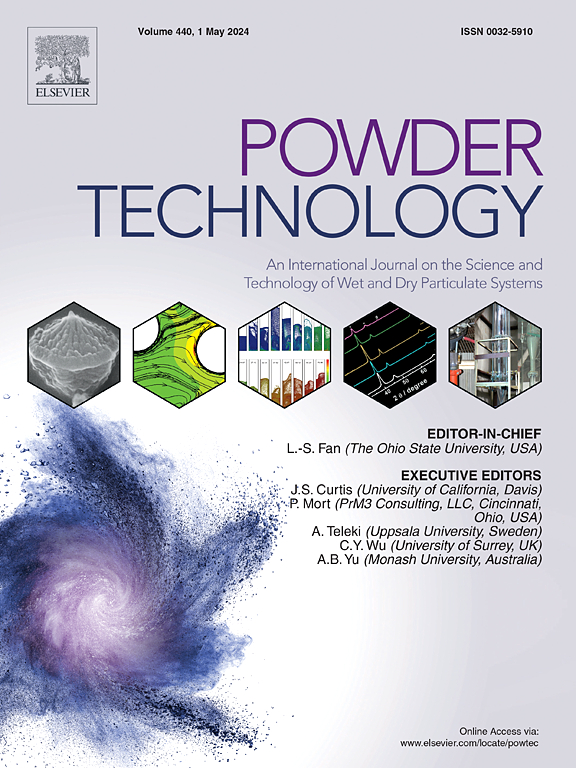Study on spatial flow field instability in a disturbing rotary centrifugal air classifier based on simulation and experimental methods
IF 4.5
2区 工程技术
Q2 ENGINEERING, CHEMICAL
引用次数: 0
Abstract
Efficient particle classification in air classifiers is essential for optimizing industrial processes. However, the instability of the flow field under loading conditions remains a challenge. The gas-solid phase is subject to complex drag forces in the flow field. An imbalance in these forces can result in phenomena such as vortex eccentricity, which adversely affects the separation of target particles. In this paper, a new disturbing rotary centrifugal classifier is designed. Furthermore, numerical simulations and experimental analyses are utilized to investigate how the operating parameters influence regional flow field instability in air classifiers under loading conditions. Following the experiments, the motion of the gas-solid phase cyclone under the influence of a double-vortex structure is explored. The results indicate that the flow field in the toothed blades area exhibits a double-vortex structure with inner quasi-forced vortices and outer quasi-free vortices. The curved impeller area flow field presents a double-vortex structure with outer axial circulation and inner secondary flow. The flow field stability depends on the stability of the double-vortex structure. The impact of double-vortex structure instability on the flow field is mitigated at a critical rotational speed of 950 rpm. Comprehensive signal and experimental analyses reveal that the flow field stabilizes and classification efficiency increases to 94.9 % at a disturbing frequency of 45 Hz (950 rpm), a feed rate of 0.3 kg/s, and an inclination of - 2°. The causes of flow field instability in classifiers are clarified, and alleviation strategies are proposed in this paper, offering valuable insights for large-scale equipment applications.

求助全文
约1分钟内获得全文
求助全文
来源期刊

Powder Technology
工程技术-工程:化工
CiteScore
9.90
自引率
15.40%
发文量
1047
审稿时长
46 days
期刊介绍:
Powder Technology is an International Journal on the Science and Technology of Wet and Dry Particulate Systems. Powder Technology publishes papers on all aspects of the formation of particles and their characterisation and on the study of systems containing particulate solids. No limitation is imposed on the size of the particles, which may range from nanometre scale, as in pigments or aerosols, to that of mined or quarried materials. The following list of topics is not intended to be comprehensive, but rather to indicate typical subjects which fall within the scope of the journal's interests:
Formation and synthesis of particles by precipitation and other methods.
Modification of particles by agglomeration, coating, comminution and attrition.
Characterisation of the size, shape, surface area, pore structure and strength of particles and agglomerates (including the origins and effects of inter particle forces).
Packing, failure, flow and permeability of assemblies of particles.
Particle-particle interactions and suspension rheology.
Handling and processing operations such as slurry flow, fluidization, pneumatic conveying.
Interactions between particles and their environment, including delivery of particulate products to the body.
Applications of particle technology in production of pharmaceuticals, chemicals, foods, pigments, structural, and functional materials and in environmental and energy related matters.
For materials-oriented contributions we are looking for articles revealing the effect of particle/powder characteristics (size, morphology and composition, in that order) on material performance or functionality and, ideally, comparison to any industrial standard.
 求助内容:
求助内容: 应助结果提醒方式:
应助结果提醒方式:


